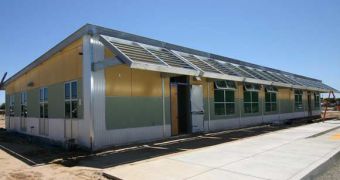The new Atwater Community Day School in Merced County, California, takes pride in being the first high school campus built using the latest sustainable prefab technology from Gen7.
Built over a period of six months only, the Gen7 Atwater campus is able to provide a safe and healthy learning environment.
The eco-friendly Gen7 campus includes a four-wing classroom building, administrative offices, art and science labs, spread over a ten-acre area.
The site integrates educational, recreational and vocational facilities to fit the needs of 200 high school students, plus 30 sixth-through eighth graders.
The campus includes state-of-the-art mechanical and ventilation systems, as well as innovative smart lighting, daylight harvesting and photovoltaic system that help make each classroom a model of energy efficiency, exceeding Title 24 energy standards by 33 percent.
"Gen7 was the ideal solution for us, setting the standard for environmental design, performance and ease of maintenance. The facility will function at a higher level and so will the students, in bright, comfortable classrooms with better lighting, top-notch acoustics and a modern appearance. We anticipate at least 30 percent savings in utility costs and expect the buildings will have a 50-year lifespan, like conventional school construction."
Aside from the Atwater Valley Community School, Gen7 projects have also been built in other Californian counties, including in Salinas, ALbany, Pasadena, and Manteca.
Gen7 is 100% recyclable, with most materials containing high amounts of recycled content. Classrooms meet LEED/CHPS standards, and the roof is engineered to allow the installation of photovoltaic power panels.
In addition, the Smart Thermal Displacement Ventilation (TDV) system reduces electricity use and costs by 35%, and sustainable products and materials are used inside and outside the classroom.
According to Gen7, green schools enjoy 20 percent higher test scores, fewer absences due to respiratory illness, lower faculty healthcare costs and higher teacher retention.

 14 DAY TRIAL //
14 DAY TRIAL //